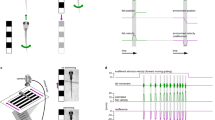Abstract
Sensory feedback allows animals to read, react, and adapt to an environment. However, the sensory information received by the body could become overwhelming, thus overloading the brain. Yet, animals are able to process all this information by canceling redundant signals from their surroundings. One species in which this phenomenon has been explored is the Apteronotus leptorhynchu (brown ghost knife fish), a small electric fish that generates a bioelectric field. Sensory signals from electrical sensing organs are passed through granular cerebellar cells, which then feedback onto the primary sensory neurons to cancel low-frequency components of the sensory information. This enables the canceling of redundant sensory information and noise and makes downstream networks more sensitive to changes in sensory input. In this preliminary study, we take the first step of replicating this functionality using a series of neural resonators. Each resonator has a unique preferred frequency and then should feed back onto the sensory signal with a frequency-specific phase delay. Our resonator is a neural “differentiator” from our prior work, which amplifies frequencies up to the cutoff frequency of the network. We propose how sensory feedback cancellation could be incorporated into bioinspired robot control.
Access this chapter
Tax calculation will be finalised at checkout
Purchases are for personal use only
Similar content being viewed by others
References
Bol, K., Marsat, G., Harvey-Girard, E., Longtin, A., Maler, L.: Frequency-tuned cerebellar channels and burst-induced LTD lead to the cancellation of redundant sensory inputs. J. Neurosci. 31(30), 11028–11038 (2011). https://doi.org/10.1523/JNEUROSCI.0193-11.2011
Metzner, W.: Neural circuitry for communication and jamming avoidance in gymnotiform electric fish. J. Exp. Biol. 202(10), 1365–1375 (1999). https://doi.org/10.1242/jeb.202.10.1365
Bastian, J.: Plasticity of feedback inputs in the apteronotid electrosensory system. J. Exp. Biol. 202(10), 1327–1337 (1999). https://doi.org/10.1242/jeb.202.10.1327
Szczecinski, N.S., Hunt, A.J., Quinn, R.D.: A functional subnetwork approach to designing synthetic nervous systems that control legged robot locomotion. Front. Neurorobotics 11, 37 (2017). https://doi.org/10.3389/fnbot.2017.00037
Nourse, W.R.P., Jackson, C., Szczecinski, N.S., Quinn, R.D.: SNS-Toolbox: an open source tool for designing synthetic nervous systems and interfacing them with cyber– physical systems. Biomimetics 8(2), 247 (2023). https://doi.org/10.3390/biomimetics8020247
Kennedy, A., Wayne, G., Kaifosh, P., Alviña, K., Abbott, L.F., Sawtell, N.B.: A temporal basis for predicting the sensory consequences of motor commands in an electric fish. Nat. Neurosci. 17(3), 416–422 (2014). https://doi.org/10.1038/nn.3650
Szczecinski, N.S., Quinn, R.D. : Leg-local neural mechanisms for searching and learning enhance robotic locomotion. Biological Cybernetics, 1–14 (2017). https://doi.org/10.1007/s00422-017-0726-x
Acknowledgments
This work was funded by NSF EFRI BRAID 2223793 to GM and NSS.
Author information
Authors and Affiliations
Corresponding author
Editor information
Editors and Affiliations
Rights and permissions
Copyright information
© 2025 The Author(s), under exclusive license to Springer Nature Switzerland AG
About this paper
Cite this paper
Johnson, S.P., Marsat, G., Szczecinski, N.S. (2025). Sensory Feedback Cancellation: Developing Resonator Networks to Mimic A. leptorhynchu’s Cerebellar Processing of Sensory Feedback. In: Szczecinski, N.S., Webster-Wood, V., Tresch, M., Nourse, W.R.P., Mura, A., Quinn, R.D. (eds) Biomimetic and Biohybrid Systems. Living Machines 2024. Lecture Notes in Computer Science(), vol 14930. Springer, Cham. https://doi.org/10.1007/978-3-031-72597-5_8
Download citation
DOI: https://doi.org/10.1007/978-3-031-72597-5_8
Published:
Publisher Name: Springer, Cham
Print ISBN: 978-3-031-72596-8
Online ISBN: 978-3-031-72597-5
eBook Packages: Computer ScienceComputer Science (R0)




